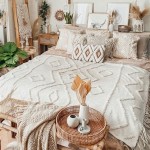Examples of Decorative Design
Decorative design encompasses a broad spectrum of artistic techniques and aesthetic principles applied to enhance the visual appeal of objects, spaces, and environments. It moves beyond mere functionality, aiming to imbue surfaces and forms with beauty, personality, and cultural significance. Decorative design can be found in various contexts, from the ornamentation of everyday items to the elaboration of architectural structures. This article will explore diverse examples of decorative design, highlighting key principles and illustrative cases across different periods and cultures.
Textile and Fabric Decoration
Textile and fabric decoration represents a significant area within decorative design, offering a vast array of techniques for embellishing surfaces. These techniques serve not only an aesthetic purpose but can also convey social status, cultural identity, or historical narratives. Embroidery, for example, involves applying decorative stitches to fabric using a needle and thread. This can range from simple, repetitive patterns to complex, pictorial representations. Historical examples include the Bayeux Tapestry, a medieval embroidered cloth depicting the Norman Conquest of England, illustrating both decorative and historical functions.
Another prominent example is tapestry weaving, where colored weft threads are intricately interwoven with warp threads to create elaborate designs. Unlike printing or painting, where the design is applied to the surface, tapestry designs are integral to the fabric’s structure. The Gobelins Manufactory in France is renowned for its exquisite tapestries, which often depicted historical events, mythological scenes, and portraits. These tapestries were historically used to adorn the walls of opulent residences, providing insulation and serving as a display of wealth and artistic patronage.
Printed textiles also offer diverse decorative possibilities. Techniques such as block printing, screen printing, and digital printing allow for the application of patterns and images to fabrics with varying degrees of complexity and scale. Indian block-printed textiles, for example, often feature intricate floral and geometric motifs, using natural dyes to create vibrant and durable designs. Screen printing, a more modern technique, allows for the mass production of textiles with highly detailed designs, frequently used in fashion and interior decoration. The use of batik, a wax-resist dyeing technique originating in Indonesia, results in unique and complex patterns on fabric, often imbued with symbolic meanings and cultural significance.
Architectural Ornamentation
Architectural ornamentation plays a crucial role in enhancing the aesthetic appeal of buildings and structures. It involves the application of decorative elements to various architectural components, such as facades, ceilings, walls, and columns. Different historical periods and architectural styles have distinct approaches to ornamentation, reflecting prevailing cultural values and artistic sensibilities.
Classical architecture, exemplified by ancient Greek and Roman buildings, heavily relies on the use of orders, which include columns, entablatures, and pediments. These elements are often adorned with intricate carvings and moldings. The Doric, Ionic, and Corinthian orders each have specific decorative features, such as the volutes of the Ionic capital or the acanthus leaves of the Corinthian capital. These details contribute to the overall visual harmony and grandeur of the building.
Gothic architecture, prevalent in medieval Europe, is characterized by its soaring height, pointed arches, and intricate tracery. Stained glass windows, another key decorative element, flood the interiors with colored light, creating a mystical and awe-inspiring atmosphere. Gargoyles and grotesques, often sculpted as fantastical creatures, adorn the exterior of Gothic cathedrals, serving both decorative and symbolic purposes. The elaborate sculptural programs found on Gothic facades depict biblical scenes and moral lessons, adding layers of meaning to the architectural design.
Art Deco architecture, popular in the 1920s and 1930s, embraced streamlined forms, geometric patterns, and luxurious materials. Ornamentation often includes stylized floral motifs, sunburst patterns, and zigzags. The Chrysler Building in New York City, with its distinctive sunburst crown and eagle gargoyles, exemplifies the Art Deco aesthetic. The use of stainless steel, glass, and other modern materials further contributed to the sleek and sophisticated appearance of Art Deco buildings.
Ceramic and Pottery Decoration
Ceramic and pottery decoration involves the application of various techniques to embellish clay objects, ranging from utilitarian vessels to purely decorative pieces. These techniques can be applied before, during, or after the firing process, resulting in a diverse range of surface treatments and visual effects. The choice of decoration often reflects the cultural context in which the pottery is produced, as well as the intended function of the object.
One common technique is glazing, which involves applying a vitreous coating to the surface of the ceramic object. Glazes can be transparent, translucent, or opaque, and they can be colored using various metallic oxides. Different firing temperatures and atmospheric conditions can affect the color and texture of the glaze, resulting in unique and unpredictable results. Ancient Chinese porcelain, known for its delicate forms and translucent glazes, exemplifies the artistry of ceramic decoration.
Another decorative technique is sgraffito, which involves scratching through a layer of slip (a liquid clay mixture) to reveal the underlying clay body, creating a contrasting design. This technique is often used to create bold, graphic patterns and images. Decorative slip trailing, where slip is applied to the surface of the ceramic object using a syringe or other tool, allows for the creation of raised, textured designs.
Painting is another widely used method for decorating ceramics. Underglaze painting involves applying pigments to the surface of the object before glazing, while overglaze painting involves applying pigments after glazing and firing. Majolica ware, a type of tin-glazed earthenware, is often decorated with vibrant, hand-painted designs depicting historical scenes, mythological figures, and floral motifs. The use of decals, which are transfer prints applied to the surface of the ceramic object and then fired, allows for the mass production of highly detailed designs.
Furniture Embellishment
Furniture embellishment encompasses a range of techniques employed to enhance the aesthetic appeal of furniture pieces. These techniques can involve surface decoration, structural alterations, and the incorporation of decorative hardware. The style of furniture embellishment often reflects the prevailing aesthetic trends of a particular historical period or cultural context.
Marquetry, a technique involving the inlaying of thin veneers of wood, ivory, shell, or other materials into a wooden surface, is a prominent example of furniture embellishment. Different types of wood can be used to create contrasting colors and patterns, while intricate designs can be achieved through careful cutting and assembly. Boulle work, named after the French cabinetmaker André-Charles Boulle, involves the use of tortoise shell and brass in marquetry, creating opulent and visually striking effects.
Carving is another common method for embellishing furniture. Relief carving, where designs are raised above the surrounding surface, can be used to create decorative moldings, panels, and other ornamental features. Intaglio carving, where designs are incised into the surface, can be used to create subtle and elegant details. The elaborate carvings found on Baroque furniture, often depicting floral motifs, scrollwork, and mythological figures, exemplify skill in decorative carving.
Painting and gilding are also used to enhance the visual appeal of furniture. Painted furniture can be decorated with a wide range of colors, patterns, and images, while gilding involves applying thin layers of gold leaf to the surface, creating a luxurious and reflective finish. The use of decorative hardware, such as handles, knobs, and hinges, can also contribute to the overall aesthetic of the furniture piece. These elements are often crafted from materials such as brass, bronze, or silver, and they can be adorned with intricate designs and embellishments.
Metalwork and Jewelry Decoration
Metalwork and jewelry decoration represent a specialized area within decorative design, focusing on the embellishment of metallic objects and adornments. These techniques often involve manipulating the metal itself, as well as incorporating other materials such as gemstones, enamel, and glass. The ornamentation can serve both functional and symbolic purposes, reflecting the cultural values and social status of the wearer or owner.
Engraving, a technique involving the incising of designs into the surface of metal using a sharp tool called a burin, is a common method for decorating metal objects. Engraved designs can range from simple lines and patterns to complex pictorial representations. Chasing and repoussé are techniques used to create relief designs on metal surfaces. Chasing involves using a hammer and punches to create indentations on the front of the metal, while repoussé involves hammering the metal from the back to create raised areas.
Enameling, the process of fusing colored glass to a metal surface, allows for the creation of vibrant and durable decorative elements. Cloisonné enamel involves creating compartments (cloisons) on the metal surface using thin wires, which are then filled with enamel and fired. Champlevé enamel involves carving depressions into the metal surface, which are then filled with enamel and fired. The use of gemstones, such as diamonds, rubies, and sapphires, is another common method for decorating jewelry and other metal objects. Gemstones can be cut and polished to enhance their brilliance, and they can be set into the metal in a variety of ways, such as prong settings, bezel settings, and channel settings.
Filigree, a delicate and intricate form of metalwork, involves creating designs using fine wires that are soldered together. Granulation, a technique involving the application of small granules of metal to a surface, creates a textured and visually appealing effect. The cultural significance of metalwork and jewelry decoration can be seen in various traditions around the world, such as the intricate silver filigree jewelry of Portugal or the elaborately decorated gold ornaments of ancient Egypt.

Color Design Drawing Img 47 Jpg

Decorative Design

Implementation Of Decorative Design In Dress Designing Textile Learner

Color Design Drawing Img 60 Jpg

Color Design Drawing Img 102 Jpg

An Example Of The Design Project Decorative Scientific Diagram

Color Design Drawing Img 100 Jpg

Polyurethane Ornament P8065 Decorative Design P80 Decoration

Ornamental Artvee

Polyurethane Ornament P8065 Decorative Design P80 Decoration
Related Posts







